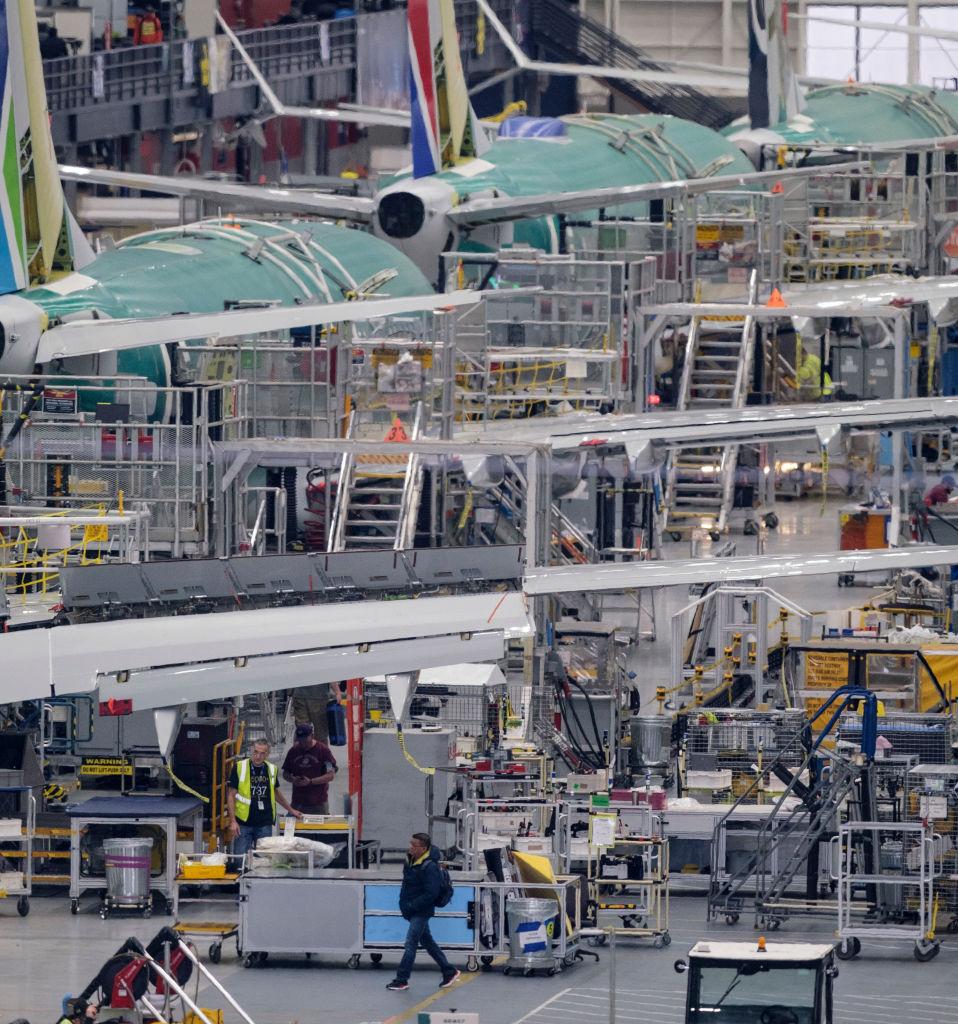Dialing Down Expectations Of Narrowbody Build Rates | ナローボディ機の生産数予測、下方修正か

あまりに多くの不確定要素があることから、今年から来年にかけてのナローボディ機生産数がどの程度になるのか、未だにそれを推測することは難しい。
しかし金融アナリストの間では、ひとつのことが確実になりつつある。それは、今でもエアバス・ボーイング両社は楽観しすぎであり、両社とも今月中に生産数予測を下方修正する可能性があるということだ。
ブルームバーグ社のアナリスト・ George Ferguson氏およびFrancois Duflot氏は3月26日、「エアバス社は年末までに月産45機への拡大を目指しているが、これでも楽観的に感じられる。おそらく月産30機に削減されるだろう」と述べた。
一方のボーイング社は、保管中の410機もの737MAXを12月までに納入する方針を半減させ、2022年初頭までに737を毎月31機生産することで、製造数の明確化を図っていると両氏は話す。また、ウィチタにある Spirit AeroSystems社には130機程度の737用部品が保管されていることを指摘する声もあり、デリバリー前の完成機が計540機保管されていることを意味する。
これは、2020年末まで約1年半にかけて737MAXが飛行停止となっていた間に、製造数とデリバリー数が乖離し、在庫が積み上がっていったことが原因だ。さらに悪いことに、欧米の保健機関は新たな変異種やパンデミック疲れに伴う、さらなる新型コロナ感染拡大を警告している。これにより、数ヶ月前に受領を急ぎたい意向を示していた航空会社も、今やそれほど急ぐ必要もなくなっていることも考えられる。
これについてFerguson、Duflot両氏は「多少は収益を見込める時期が近付いているとはいえ、さらなる新型コロナ感染拡大のリスクや、多くの航空会社が低稼働/保管中の機材を多く抱えていることを考えると、新たなデリバリーは望んでいない。ライアンエアー・サウスウェスト・ルフトハンザ・エールフランス・ユナイテッド・アメリカン・デルタ航空といった欧米の航空会社は2020年に280億ドル以上を失っている。多くは強固な流動性ポジションを確立したとはいえ、借入も多く、機材の追加購入よりも収支の改善を優先したいだろう」と説明した。
これと同時に、 Cowen社のアナリスト・ Cai von Rumohr氏、Dan Flick氏、Scott McCrery氏が2月25日に語ったところでは、約540機の737完成機および部品が納入待ちになっていることを考えると、Spirit社が月産40機台前半まで回復するのは2024年以降になる可能性もあるという。
航空宇宙業界の経営陣を対象にアクセンチュア社が1月に実施した調査によると、サプライチェーンの主要企業は期待を高めていないことがわかる。今後6ヶ月でナローボディ機のデリバリー数が前年同期を上回ると答えたのは回答者の27%に留まり、44%は減少すると答えた。年間を通した比較では、2020年と比較して2021年の方が多くなると答えたのは49%で、34%が同等、17%は減少と答えた。
エアバス社およびボーイング社は、4月の第1四半期決算発表の際に予測を見直す機会がある。
しかし、アナリスト達も悲観的な見方ばかりしているわけではない。特に長期予想では、ナローボディ機主導で民間航空業界は回復するとみている。 Vertical Research Partners社は3月26日、有償旅客マイルが2019年の水準に回復するのは2023〜24年になると前提条件を修正した上で、エアバス・ボーイング両社によるナローボディ機のデリバリー数予測を11%上方修正した。これにより、A320は2025年に月産65機、737は月産48機に達するとしている。
Vertical社のRobert Stallard氏とKarl Oehlschlaeger氏は、「両社ともナローボディ機マーケットの回復による恩恵を受けるが、我々としてはA320が60%程度のシェアを獲得してエアバス有利になると考えている。この強力なポジションは、2023年に就航するA321XLRがマーケットのトップエンドを独占することで、さらに盤石なものになるだろう」と付け加えた。
Aviation Week Intelligence Network (AWIN) のメンバーシップにご登録いただくと、開発プログラムやフリートの情報、会社や連絡先データベースへのアクセスが可能になり、新たなビジネスの発見やマーケット動向を把握することができます。貴社向けにカスタマイズされた製品デモをリクエスト。
With so many proverbial tea leaves to read, the commercial aerospace manufacturing sector remains in a fog when it comes to guessing narrowbody build rates this year and next.
But increasingly, financial analysts are saying one thing seems sure: Airbus and Boeing still are too optimistic and both OEMs could dial back expectations this month.
“Airbus plans to increase deliveries to 45 a month by year-end, which looks optimistic,” Bloomberg analysts George Ferguson and Francois Duflot said March 26. “We expect builds to be cut to 30 a month.”
Meanwhile, Boeing has halved guidance for delivery of the roughly 410 737 MAXs in its immediate inventory by December, while reducing build-rate clarity by committing to production of 31 737s a month by early 2022, according to the analysts. Others stress that there are another 130 or so Boeing 737 shipsets parked in Wichita at Spirit AeroSystems, meaning a total undelivered backlog of around 540 aircraft.
That matters as build and delivery rates are disconnected due to inventory piling up when the MAX was grounded for a year and a half until late 2020. But with European and U.S. health officials warning about another surge of coronavirus infections due to variants and pandemic fatigue, airlines may not be in as much of a rush now to take deliveries as they indicated just a few months ago.
“Even as slight cash generation approaches, the risk of another COVID-19 wave and large number of underused or stored aircraft has most carriers resisting new deliveries,” Ferguson and Duflot said. “Airlines in the U.S. and Europe, including Ryanair, Southwest, Lufthansa, Air France, United, American and Delta, burned over $28 billion in 2020. Most have built up strong liquidity positions, yet many used debt and would prefer to improve the balance sheet rather than buy more planes.”
At the same time, given the roughly 540 completed 737s/shipsets yet to be delivered, it may well take until 2024 for Spirit to reach the low 40s in new production, Cowen analysts Cai von Rumohr, Dan Flick and Scott McCrery said Feb. 25.
Supply chain leaders are not raising their hopes, according to the Accenture aerospace executive survey from January. Only 27% of surveyed aerospace executives expect narrowbody aircraft deliveries to increase over the next six months compared to a year before, while 44% expected unit delivery decreases. For year-over-year comparisons, only 49% expect an increase for 2021, while 34% think their related deliveries will remain the same and 17% still expect a cut for 2021 compared with 2020.
Airbus and Boeing face an opportunity to alter their forecasts in April when they report first-quarter financial results.
Still, analysts are not all doom and gloom, particularly as their long-term forecasts nonetheless call for a narrowbody-led recovery in commercial aviation. Having tweaked their base-case scenario on RPMs to a recovery to 2019 levels in 2023-24, Vertical Research Partners on March 26 also increased their Airbus and Boeing narrowbody delivery forecasts by an aggregate 11% over 2021-2025. This sees the A320 getting up to a rate of 65/month in 2025, and the 737 improving to 48/month in the same year.
“While both OEMs should benefit from a recovery in the narrowbody market, we think Airbus is the better placed with its [roughly] 60% market share for the A320 versus the 737 MAX,” added Vertical’s Robert Stallard and Karl Oehlschlaeger. “This strong position looks set to be further boosted by the entry into service of the A321XLR in 2023, further enhancing its dominant position at the top end of the narrowbody market.”